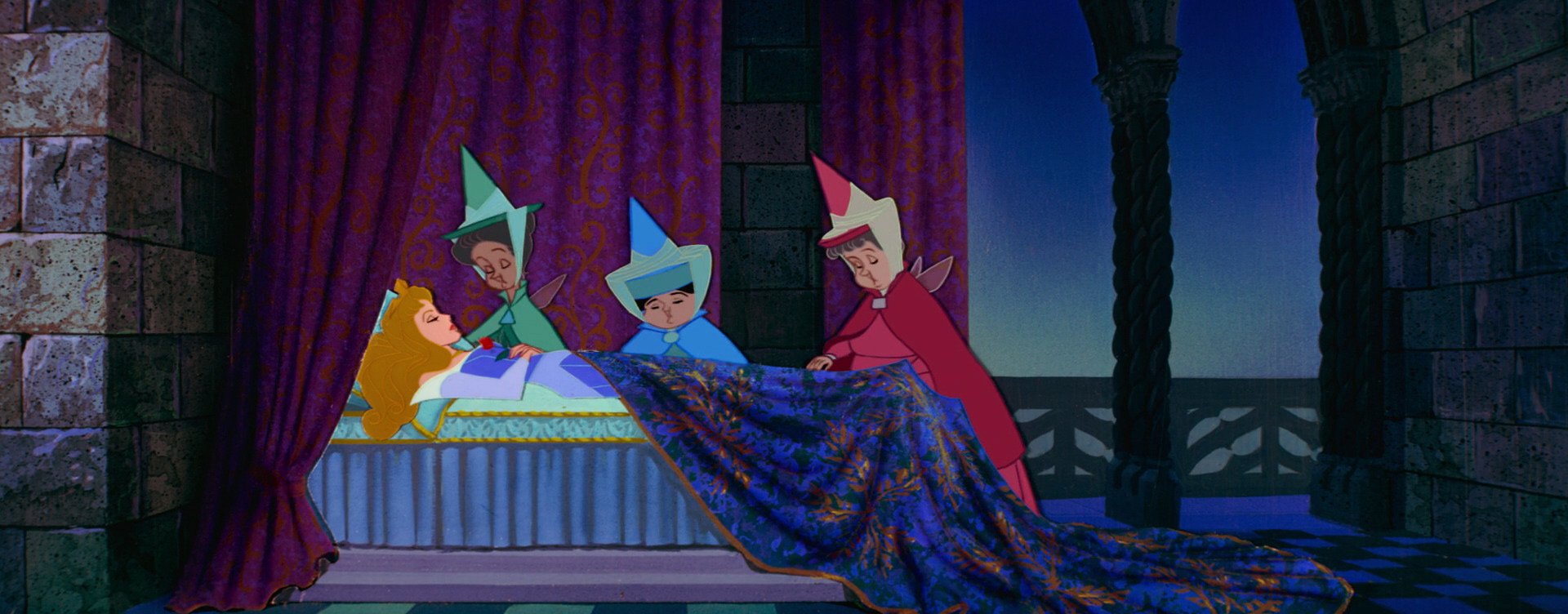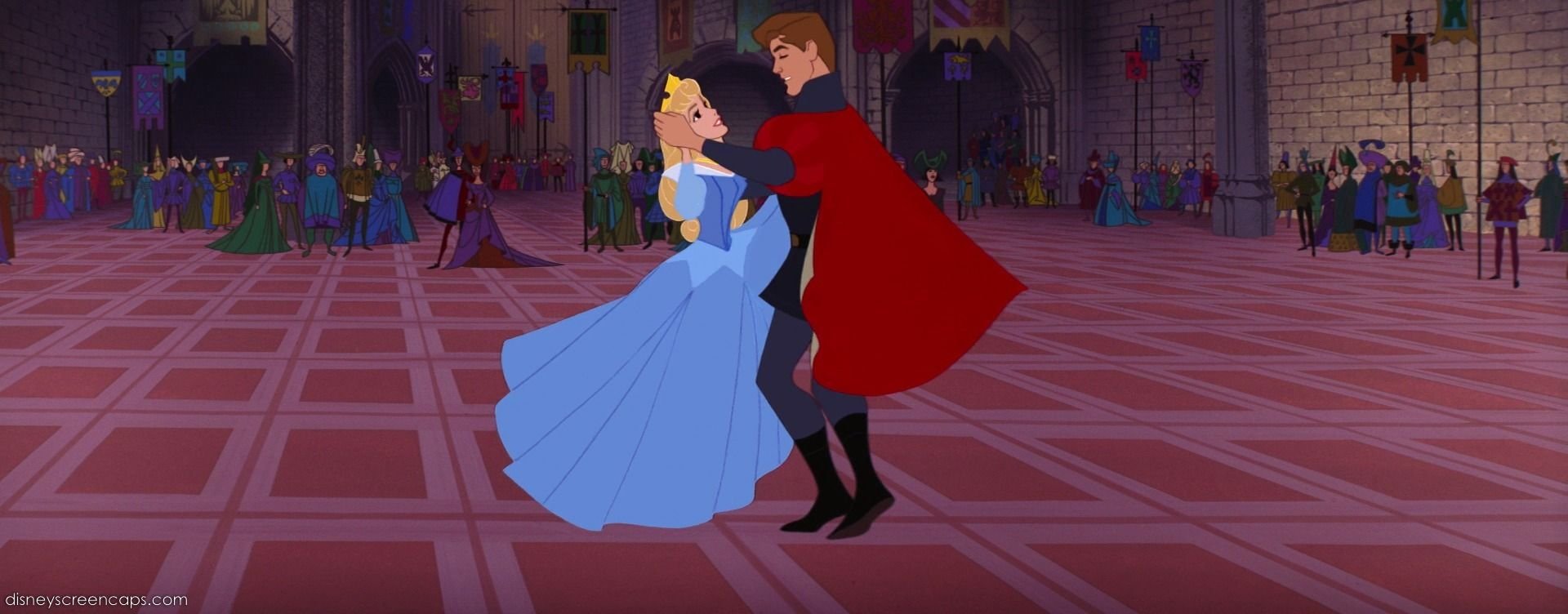The Innovations and Artistry of Sleeping Beauty
Something that Walt desired in his lifetime was to leave a sustaining legacy behind, and this is evident in almost every decision he made. From creating a 160-acre theme park in the heart of California, to achieving great innovative success in film technology, to being a part of the early development of AI through robots and audio-animatronics. Every step of Walt’s career was toward something that he would become synonymous with forever, and the 1959 version of Sleeping Beauty was intended to be the absolute pinnacle of his lifetime. Walt put tremendous expectation on the film as he wanted it to encompass everything he was passionate about: storytelling, reimagining, beautiful artistry, and making an audience feel something. Though Sleeping Beauty did not initially perform as well as the studio had hoped, it has since become a classic that has left a lasting legacy.
Sleeping Beauty (1959). Image from: https://letterboxd.com/film/sleeping-beauty/
The original story of sleeping beauty
Disney’s fascination with fairytales is carried through each era of the studios filmography, beginning with the retelling of Snow White and the Seven Dwarfs. Snow White was written in 1812 by the Brothers Grimm, and Disney took creative liberties in leaving out details from the original story, like Snow White’s mother dying at her birth, the Evil Queen’s three attempts at poisoning her, and the Evil Queen’s punishment by death at the end of the story. As we could imagine, details such as these may be too gruesome and dark for a movie intended for a child audience.
The same could be said for the original tale of Sleeping Beauty, which can be traced back to a tale called The Sun, The Moon, and Talia by Giambattista Basile in 1634. The story went that a great lord had a daughter who was destined to be in danger if ever around a splinter of flax. When his daughter Talia grew older, she ended up coming in contact with a splinter of flax when she saw an old woman with a spindle outside her window. She fell seemingly dead, and her father left her in a mansion where she lie resting. A king encountered Talia in the mansion some time later, leaving her pregnant with two children. She awoke to her two children, sun and moon, and the king returned to take care of them. The king’s queen grew suspicious of him leaving to “hunt” in the woods so often, and she found out about Talia and the children. She invited the children to stay with her and the king, but she really asked the cook to kill the children and feed them to her husband. The cook grew frightened and did not follow through, but the queen wasn’t aware. The queen continued to want revenge on Talia, intending to throw her into a fire, until the king arrived. The king then command that the queen be thrown into the fire for the evil she had done, and the cook reveals that the two children are alive.
This story was rewritten and retold by Charles Perrault in 1697 called The Sleeping Beauty in the Wood, and again in 1812 with the Brothers Grimm collection, this time titled Little Briar Rose. Sleeping Beauty is one of the oldest fairytales Disney ever adapted, landing in second place alongside Cinderella and Tangled.
From The Sun, The Moon, and Talia. Grimm’s Fairy Tales illustrated by Millicent Sowerby. Image from: https://www.pookpress.co.uk/sun-moon-talia/
the decision to make sleeping beauty and the story development
The way Disney’s filmography has panned out is not exactly how it was originally intended to be, as Walt had many ideas for what stories he wanted to tell. Stories like The Little Mermaid, Beauty and the Beast, Alice in Wonderland and Peter Pan were all being workshopped and even had preliminary storyboards made in the 1930s, with the possibility of any of them being the first feature-length animated film. Sleeping Beauty was considered in 1939, with writer Joe Grant working through story development at that time, but it never followed through.
After the major successes of Cinderella in 1950, starting a new era for the studio after a bleak time during WWII, the studio felt like it was the right time to bring back another fairytale. It was a risky move though, as they were worried that audiences may start to feel that fairytales was all Disney would ever be good at and known for. It was imperative that they made Sleeping Beauty stand out from the rest and demonstrate the studio’s ability to be innovative and progressive.
Princess Aurora and Prince Phillip. Image from: https://www.pinterest.ca/pin/486740672203664911/
There were several versions that writers Bill Peet, Ted Sears, Winston Hibler, and Ralph Wright worked through. Originally, Maleficent was to be a fourth fairy alongside Flora, Fauna and Merryweather (originally named Tranquility, Fernadell, and Merryweather). Princess Aurora would also be trapped within the castle walls. It became too similar to both Snow White and Cinderella, so the writers reworked it so that Aurora would have no knowledge that she ever was a princess, and she would hide out in a cottage with the three fairies. It was also decided that Prince Phillip would get more of a storyline and the audience would be able to get to know him as a character as well, since the attention on the Princes in past films had never been focused on before.
The innovations of sleeping beauty
In an attempt to make it stand out even more, Disney began experimenting with some new techniques for the movie. One of which was playing with the aspect ratio of the film and releasing it in a widescreen format. They released it in Super Technirama 70mm, which was the first time it had ever been used. It was one of only two times Disney would ever do this, the other time being with The Black Cauldron in 1985.
In terms of the music, Disney was drawn to classical musicians from the early days, with Stravinsky’s influence on Fantasia and Prokofiev’s involvement in Make Mine Music. Disney drew from Pyotr Ilyich Tchaikovsky’s Sleeping Beauty ballet for the music in the film, specifically for “Once Upon A Dream”. It was sung by Aurora’s voice actress Mary Costa and Prince Phillip’s voice actor Bill Shirley.
For the look of the movie, it was decided early on that the primary focus would be the artwork of the designs, from the backgrounds to the characters. It would be dubbed “a moving illustration” by Walt himself, and it was important that it didn’t veer from that vision. Artist Eyvind Earle was hired to do the styling, colouring, and backgrounds for Sleeping Beauty.
“For years and years I have been hiring artists like Mary Blair to design the styling of a feature, and by the time the picture is finished, there is hardly a trace of the original styling left. This time Eyvind Earle is styling Sleeping Beauty, and that’s the way it’s going to be!”
Prince Phillip and Briar Rose meet, Sleeping Beauty. Image from: https://letterboxd.com/film/sleeping-beauty/
eyvind earle on sleeping beauty
Eyvind had an illustrious life filled with art beginning at a young age. At just 21 years old, he bicycled from Los Angeles to New York on money he had made selling watercolour paintings. He held one-man shows, had his artwork up in galleries, and even the Metropolitan Museum of Art purchased one of his pieces. Before many of these accomplishments, he had applied for a job with Disney when he was 18 years old, and was rejected time and time again. He finally was hired on in 1951 as a background painter with Disney. He quickly moved up in the department and worked on backgrounds for Peter Pan, Lady and the Tramp, and many cartoon shorts.
Finally, during the development of Sleeping Beauty, Eyvind would take the lead on the creative direction and would take inspiration from the illuminated manuscript the Très Riches Heures de Jean, Duc de Berri, an opulent Book of Hours. He drew from his own style which was of Pre-Renaissance, and followed a flat, bright coloured style that used light and shadows to create perspective. He worked closely with Marc Davis, the animator for Aurora and Maleficent, and Milt Kahl, the animator of Prince Phillip. Eyvind’s work on Sleeping Beauty would be a pivotal point in his career, as he continued on working in animated art for television, and he would explore other mediums, like book illustrating and sculpting. Eyvind would be a dedicated artist until his death in 2000. He was awarded the Disney Legend award in 2015 posthumously.
Eyvind Earle artwork. Image from: https://www.muddycolors.com/2021/05/eyvind-earle-you-gotta-have-style/
sleeping beauty’s castle in disneyland
When Disney announced that they were planning to make Sleeping Beauty in the early 1950s, it was right around the time the development of Disneyland was underway. Walt was insistent on having some kind of medieval castle tower over the park, and act as an icon for Disneyland. It would be carried over into everything they do, from their logo, to their films and TV shows, and everything in between. Originally, the castle wasn’t meant to have a specific inhabitant or royal family, it would simply be “Fantasyland Castle”. It was also tossed around that the castle belong to Snow White, as the very first princess. However, with Sleeping Beauty in the works and Walt putting so many expectations on both the castle and the movie to be something he would forever be remembered for, the two were linked. It would become Sleeping Beauty’s Castle as a marketing strategy to entice guests to see the movie when it was released.
Sleeping Beauty’s Castle. Image from: https://www.travelandleisure.com/trip-ideas/disney-vacations/disneyland-secrets-you-probably-didnt-know
Sleeping Beauty stands today as one of the greatest animated films of all time, in terms of styling, music, characters and storyline. It joined the National Film Registry in 2019.
Reference list:
https://sites.pitt.edu/~dash/type0410.html#basile
https://d23.com/sleeping-beauty-stunning-art/
https://www.laughingplace.com/w/articles/2014/10/06/from-the-vault-the-history-of-sleeping-beauty/
https://www.animationmagazine.net/2019/12/sleeping-beauty-joins-national-film-registry/










